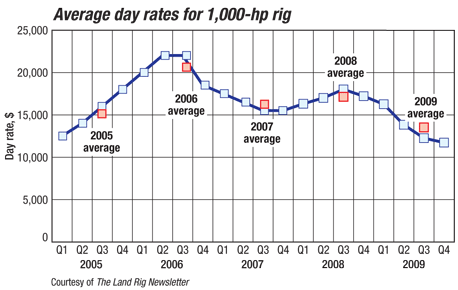Rig count to see a slow, steady recovery
Rig count to see a slow, steady recovery
There were 1,623 rotary drilling rigs operating in the US at the beginning of 2009, which ended up being the highest rig count of the entire year. The number of working rigs fell by almost 50% in the first half of the year, reaching 876 in June, which was a 57% decrease from the 22-year high of 2,031 rigs achieved at the peak of 2008. After bottoming out in June, the rig count began a slow but steady recovery to end the year at 1,179. The 2009 average rig count of 1,143 was a 39% decrease from 2008’s average of 1,879. Texas saw the steepest decrease, a 425-rig drop to 473 from an average of 898 in 2008. Nevertheless, Texas remained the rig leader by far, with more than three times as many units as the state with the next-highest rig count, Louisiana. Other states with especially large drops include Oklahoma (104-rig decrease) and Colorado (63-rig decrease). Despite the steep decline in the first half of the year, two states saw their average rig counts increase substantially from 2008: Pennsylvania saw a staggering 87% increase, and Kansas saw a nearly-as-impressive rise of 82% in its rigs. The only other increase was in Louisiana’s North district, which saw its rig count rise 34%. Going into 2010, there are signs that the recovery that began halfway through 2009 will continue throughout the year. Between Jan. 15 and Jan. 22, the US rig count rose by 34 units to 1,282—the largest week-to-week increase since March 2008. The Jan. 22 count also represents a 46% increase from the 2009 low of 876 on June 12. We are predicting a 2010 average rig count of 1,463, representing a 28% increase over last year’s average. According to NOV Downhole’s rig census (previously known as the ReedHycalog rig census), released in November 2009, the total number of US rigs increased by 93, raising the total fleet 3% to 3,169 rigs. The rapid expansion of newbuilds over the past several years has more than satisfied the reduced need for rigs, and they are still coming online at a rapid pace. Thus, rig owners have been quicker than usual to stack older, less efficient units—the number removed from service jumped 178% last year to 164, from just 59 units removed in 2008. The younger, more efficient US rig fleet explains why the decrease in the rig count was substantially steeper than the 32% drop in US wells drilled last year. US rig utilization plummeted from 83% in 2008 to 40% last year, its lowest level in more than two decades, based on a 2009 average of 1,264 rigs that NOV Downhole counts as “active.” Using the Baker Hughes rig count, utilization was even lower, at 36%. According to ODS-Petrodata, jackup utilization in the US Gulf of Mexico cratered in 2009, falling as low as 25.4% in August and still hovering around 30% by November.
According to The Land Rig Newsletter (LRNL), day rates for a typical 1,000-hp rig in the South Central US region fell in each quarter of 2009, though rates were flattening out by the fourth quarter. The average day rate for the year was $13,512, 21% down from 2008’s average of $17,125. The data used for our rig count, from Baker Hughes, represents only those rigs that are significant consumers of oilfield services and supplies. It does not include very small truck-mounted rigs or rigs that can operate without a permit. However, non-rotary rigs such as coiled tubing and workover rigs drilling new wells may be included. To be counted, a rig must be on location and be “actively” drilling. A rig is active from the moment the well is spudded until it reaches TD. Rigs that are in transit, rigging up, or performing workovers, completions or production testing are not counted. LRNL day rates represent a spot market base rate without fuel or other add-ons.
|
- Coiled tubing drilling’s role in the energy transition (March 2024)
- Using data to create new completion efficiencies (February 2024)
- Digital tool kit enhances real-time decision-making to improve drilling efficiency and performance (February 2024)
- E&P outside the U.S. maintains a disciplined pace (February 2024)
- Prices and governmental policies combine to stymie Canadian upstream growth (February 2024)
- U.S. operators reduce activity as crude prices plunge (February 2024)
- Applying ultra-deep LWD resistivity technology successfully in a SAGD operation (May 2019)
- Adoption of wireless intelligent completions advances (May 2019)
- Majors double down as takeaway crunch eases (April 2019)
- What’s new in well logging and formation evaluation (April 2019)
- Qualification of a 20,000-psi subsea BOP: A collaborative approach (February 2019)
- ConocoPhillips’ Greg Leveille sees rapid trajectory of technical advancement continuing (February 2019)



